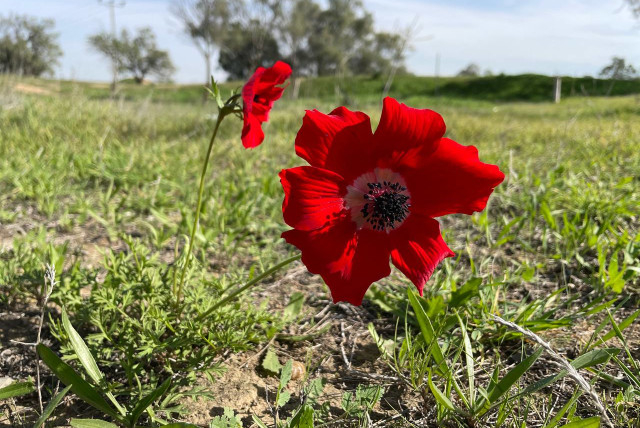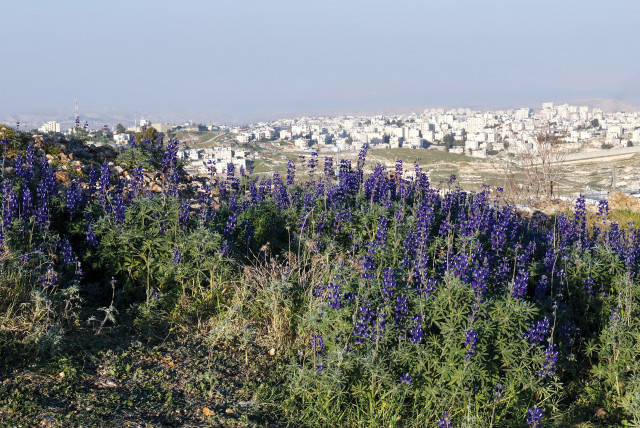Blossoms of hope: The healing power of Israel's flowers

This year, as conflict rages in Gaza, missiles are launched from Lebanon into Israel’s North, and the country is living in a state of collective trauma, a longing for nature is especially pronounced.
The allure of flowers knows no bounds. Amid the chaos in Israel, the sight of blossoms brings a much-needed respite.
So says Shay Tachnai, district manager for southern Israel at the Society for the Protection of Nature in Israel (SPNI).
“Flowers are beautiful,” he said.
This year, as conflict rages in Gaza, missiles are launched from Lebanon into Israel’s North, and the country is living in a state of collective trauma, this longing for nature is even more pronounced. Tachnai said that for Israelis displaced or affected by the turmoil, the opportunity to reconnect with nature becomes a source of rejuvenation.
“Suddenly, they have good spirits,” Tachnai said, noting nature’s transformative power on traumatized souls. “The victims are often stoic. And when they come to nature, they can suddenly let go, laugh, play, and sing.”
Israel’s southern region, the area that Hamas terrorists infiltrated on October 7, is known for its red anemones – “kalaniyot” in Hebrew.
Winter in bloom
The first red anemones of the season were seen blooming in January in the Negev’s Eshkol National Park. Their bright red color popped from the soil and stood out against the backdrop of the charred landscape that had been blackened by murder and fire only a few months prior.
In normal years, when the anemones adorn the South with a vibrant red carpet, tens of thousands of Israelis flock to see them. The anemones became especially popular with the launch of the Darom Adom (Red South) festival, founded by Ofir and Vered Libstein in 2007.
Ofir Libstein, head of the Sha’ar Hanegev Regional Council, was the first known victim of the October 7 massacre. He and his son, 19-year-old Nitzan Libstein, were murdered defending Kibbutz Kfar Aza, where they lived.
The Darom Adom festival has been held each year from mid-January until the end of February and includes enjoying red flowers, arts and crafts, and live performances. This year, there was no festival. Instead, in the aftermath of the Hamas massacre, the residents of the Gaza border communities asked the public not to come, Tachnai said.
“They said, ‘We always host you for the anemones. We are not home now and cannot host you, so please do not go see the flowers without us,’” Tachnai said.
Moreover, most areas where the festival would have been hosted are closed-off military zones. One of the sole locations in the South where anemones bloom and visitors are allowed is Re’im forest, the site of the Supernova music festival tragedy, now commemorated with a memorial.
Due to decreased rainfall, Tachnai noted, this year’s anemones are shorter and smaller than usual.
The year 2023 was unique in Israel’s rainfall and, therefore, its floral landscape. The North and Center regions received over 1.5 times the typical annual rainfall. However, the South saw only 70%.
Tachnai pointed out that most rainfall in the South occurred in January. As such, the flowers blossomed splendidly toward the end of January and throughout February. However, as February transitioned into March, the region experienced a lack of rainfall, resulting in significant dryness. In areas farther south, such as Sde Boker, where the annual average rain typically reaches around 100 millimeters, precipitation amounted to less than 20 millimeters.
Tachnai said that the reduced rain may be a result of climate change, although there have been years before when there was less rain. Last year, however, there was more rain in the South and a little less than average in the North.
“We often see these ups and downs,” he said.
The war has caused damage to the soil, too – mostly in agricultural areas, from the Hamas massacre and fires and Israeli military vehicles. However, tanks and heavy vehicles also harmed open spaces and nature reserves. For instance, the Be’eri Badlands Nature Reserve was flattened, and Shokeda Forest, known for wild anemones, was damaged. However, because most military activities occurred right after the attack in October and November, and rain mostly came in January, flowers still managed to grow in most cases.
There are other locations where red anemones can be seen even now, Tachnai said: Megiddo, Afula, Srigim, Emek Hashalom, and others. In the area around Yokne’am, there are anemones of many colors, including blue and white.
WITH TRAVEL restrictions in place, another scenic spot has emerged as a popular destination this year: Lupine Hill in Jerusalem’s Armon Hanatziv neighborhood. This picturesque hill is adorned with thousands of vibrant purple flowers.
Amanda Lind, director of the Gazelle Valley in Jerusalem, an urban nature reserve owned by the municipality and directed by SPNI, tells the story of how those flowers arrived at the hill. She explained that the Jerusalem Botanical Gardens has had a wildflower project since the 1980s, collecting wild seeds, including lupines.
“They collected a handful of wild lupine seeds and grew them in the botanical gardens, and now the gardens are full of these flowers,” Lind said. Two kilos of these seeds were then given to former mayor Teddy Kollek, who put them on the hill in Armon Hanatziv, where they have been growing wildly ever since.”
Kollek was mayor from 1965 to 1993.
Lind explained that lupines are legumes – from the same family as broad beans – and their seeds are similar in shape, although poisonous. Their roots have little nodes that put nitrogen into the soil, so they improve the soil as they grow.
Lind said the more they grow, the more fertile the soil becomes, preparing for the next generation. The plants also increase quickly.
“If you have one plant, then the next year you will have five; they multiply over the years,” Lind said, adding that the stunning Jerusalem hill “shows the beauty of a success in nature.”
The lupine flowers will come to the end of their season by the end of the month and then set for the summer when it is dry.
“They need the dry period when the seeds are in the ground. Then, they will sprout again with the rain in the autumn – and we may get even more,” Lind said.
She explained that Jerusalem has a wide variety of plant life because of its cool nights. The other day, Lind said, she was driving near the Biblical Zoo when she spotted a wild orchid growing in the middle of a traffic circle.
According to a recent survey, Jerusalem has 150 urban nature sites – “a huge number,” said Lind – which includes community gardens that are also public green spaces.
“I think it is important that we have these places that are not so developed – not an adventure playground or park, but places that are untouched as much as possible,” Lind said.
She added that the best way to take care of local flowers is to “leave them alone. Do not do anything. No sprays. No nasty pesticides. We want to let wildflowers do their thing.”
Like Tachnai, Lind highlighted the importance of nature for health and simply recharging.
“I think that is why so many people rush to nature,” she said. “It is essential for our well-being.
“We need to protect our open spaces.”
THE HOPE is that soon the victims of the October 7 massacre will return to their homes in the South. The country has devised a plan and committed NIS 18 billion over the next five years to rehabilitate the devastated communities. The plan includes new paths to economic prosperity, such as increased industry and solar energy fields.
Tachnai praised the plan but said, “The reason people came to the South was for its open spaces, its nature, and its views. What will rehabilitate the community more than anything is to return to these same views.
“To rehabilitate the community, we need to repair nature,” he continued. “Only when we see the flowers blooming will there really be rehabilitation in these areas.”
The Environment and Climate Change portal is produced in cooperation with the Goldman Sonnenfeldt School of Sustainability and Climate Change at Ben-Gurion University of the Negev. The Jerusalem Post maintains all editorial decisions related to the content.
Jerusalem Post Store
`; document.getElementById("linkPremium").innerHTML = cont; var divWithLink = document.getElementById("premium-link"); if (divWithLink !== null && divWithLink !== 'undefined') { divWithLink.style.border = "solid 1px #cb0f3e"; divWithLink.style.textAlign = "center"; divWithLink.style.marginBottom = "15px"; divWithLink.style.marginTop = "15px"; divWithLink.style.width = "100%"; divWithLink.style.backgroundColor = "#122952"; divWithLink.style.color = "#ffffff"; divWithLink.style.lineHeight = "1.5"; } } (function (v, i) { });


